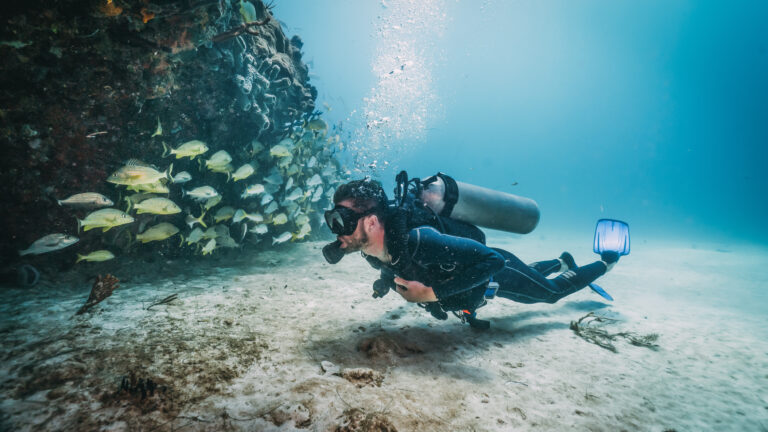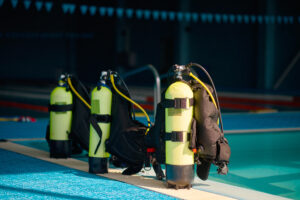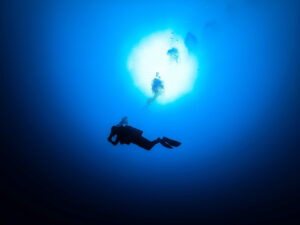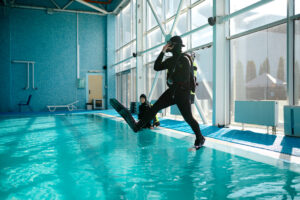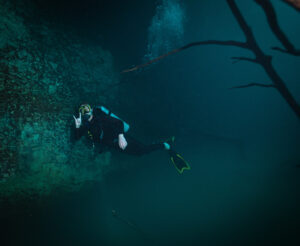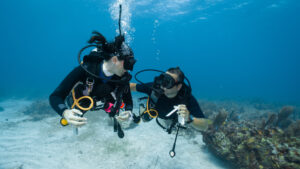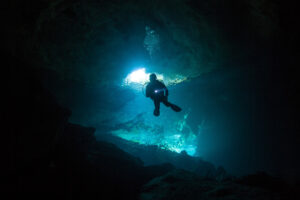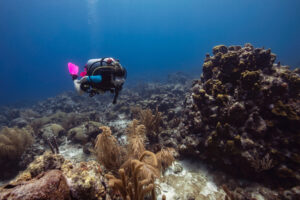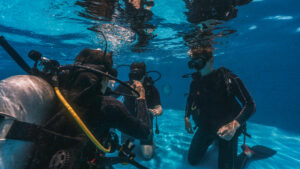What is a Low Volume Mask?
A low volume mask is a specific type of diving mask designed to minimize the internal air space between the diver’s face and the lens. This reduced volume makes it easier to equalize pressure and clear the mask of water, enhancing comfort and efficiency, especially in activities such as freediving and spearfishing. Low volume masks are distinguished by their close-fitting design and the ability to improve a diver’s overall underwater experience by offering a broader field of vision and less buoyancy.
Historical Development
The concept of the low volume mask can be traced back to the early days of diving when divers sought to overcome the challenges associated with traditional, high-volume masks. Traditional masks, which often had large internal volumes, required significant effort to equalize pressure and clear water, leading to discomfort and reduced efficiency. The drive to improve this aspect of diving gear led to the development of more compact designs.
In the mid-20th century, the evolution of diving technology saw significant advancements in mask design. Pioneers in the diving industry began experimenting with materials and shapes to reduce the mask’s internal volume. One of the key innovations was the introduction of softer, more flexible materials for the mask skirt, which allowed for a closer fit to the face. This innovation not only reduced the mask volume but also improved the seal, preventing water from leaking in.
Throughout the decades, the low volume mask continued to evolve, with various manufacturers introducing their own versions, each incorporating unique features to enhance performance. The 1980s and 1990s saw a surge in popularity for low volume masks among freedivers and spearfishers, who particularly benefited from the ease of equalization and improved hydrodynamics. Today, the low volume mask is a staple in the diving community, celebrated for its practical benefits and ergonomic design.
Design and Features
Low volume masks are characterized by their sleek, compact design, which sets them apart from traditional diving masks. The primary feature of a low volume mask is the reduced internal space between the lens and the diver’s face. This design minimizes the amount of air that needs to be equalized, making it easier for divers to adjust to changing pressure levels underwater.
The frame of a low volume mask is typically narrower, and the lenses are closer to the eyes. This proximity to the eyes not only helps reduce volume but also significantly enhances the diver’s field of vision. Divers can see more of their surroundings without having to move their head as much, which is particularly advantageous in environments requiring heightened awareness, such as when navigating through coral reefs or hunting fish.
Materials used in low volume masks are selected for their durability, flexibility, and comfort. The skirt of the mask, which creates the seal against the diver’s face, is usually made from high-quality silicone. Silicone is favored for its ability to conform to the contours of the face, providing a secure seal that prevents water from entering the mask. The lens is often made from tempered glass, which is both strong and resistant to scratches, ensuring clear visibility.
One of the technical specifications that divers look for in a low volume mask is the angle of the lens relative to the face. Modern low volume masks often feature inclined lenses, which further improve the field of vision and reduce the internal volume. The strap system is also designed for ease of adjustment, allowing divers to achieve a snug fit quickly and efficiently.
Advantages of Low Volume Masks
Low volume masks offer several advantages that make them a preferred choice for many divers. One of the most notable benefits is the enhanced field of vision. Because the lenses are closer to the eyes, divers can see more of their surroundings without needing to turn their heads. This wide field of vision is particularly beneficial in underwater environments where situational awareness is crucial.
Another significant advantage is the ease of equalization. The reduced air volume inside the mask means that divers need to exert less effort to equalize pressure as they descend. This is especially important in freediving, where rapid descents are common, and equalization needs to be performed quickly and efficiently. The ease of equalization not only makes diving more comfortable but also helps prevent potential barotrauma, a condition caused by pressure changes.
Comfort and fit are also major benefits of low volume masks. The ergonomic design and the use of high-quality silicone for the skirt ensure a snug and comfortable fit, reducing the likelihood of leaks. The close-fitting design also means that the mask is less prone to shifting during a dive, providing a stable and secure experience. Additionally, the reduced buoyancy of the low volume mask can contribute to better overall buoyancy control, which is crucial for maintaining proper diving technique.
In terms of performance, low volume masks are favored by freedivers and spearfishers because they streamline the diver’s profile, reducing drag and making it easier to move through the water. This hydrodynamic advantage allows for more efficient movement, conserving energy and extending the duration of dives. Furthermore, the lightweight nature of low volume masks makes them easier to carry and pack, a practical benefit for divers traveling to remote locations.
Usage in Different Diving Situations
Low volume masks are versatile and can be used in various diving situations, each with specific benefits. In recreational scuba diving, these masks provide an improved field of vision and ease of equalization, making the diving experience more enjoyable. Divers can appreciate the underwater scenery more fully and adjust to pressure changes with less effort, enhancing overall comfort and safety.
In freediving and spearfishing, low volume masks are particularly valuable. Freedivers benefit from the minimal air volume that needs to be equalized, allowing for smoother and faster descents. The enhanced field of vision is also crucial in freediving, where divers rely on visual cues to navigate and avoid obstacles. Spearfishers appreciate the streamlined design, which reduces drag and allows for quicker, more efficient movements underwater. The ability to see more clearly and move with less resistance can make a significant difference in catching fish.
Underwater photographers and videographers also find low volume masks advantageous. The broader field of vision allows for better framing of shots and a more immersive viewing experience. The close-fitting design helps maintain a stable position, reducing the likelihood of mask movement that could disrupt the shot. This stability is essential when capturing high-quality images and videos in dynamic underwater environments.
However, it is important to note that low volume masks may have some limitations in extreme diving conditions. In cold water diving, for example, the smaller air space can lead to faster fogging of the lens. Divers in such conditions need to take extra precautions, such as using anti-fog solutions or ensuring proper ventilation of the mask. Similarly, in environments with strong currents or rough conditions, the secure fit of the mask becomes even more critical to prevent water from entering.
Maintenance and Care
Proper maintenance and care of low volume masks are essential to ensure their longevity and optimal performance. Regular cleaning is crucial to prevent the buildup of salt, sand, and other debris that can damage the mask or reduce visibility. After each dive, the mask should be rinsed thoroughly with fresh water to remove any salt and debris. A mild soap can be used to clean the skirt and frame, but it is important to avoid abrasive cleaners that could scratch the lens.
Storage is another important aspect of mask care. When not in use, the mask should be stored in a cool, dry place away from direct sunlight. Prolonged exposure to sunlight can degrade the silicone and other materials, leading to premature wear and tear. It is also advisable to store the mask in a protective case to prevent accidental damage.
To preserve the performance of the mask, divers should inspect the skirt and strap regularly for signs of wear or damage. Any cracks, tears, or deformations in the silicone can compromise the seal and lead to leaks. Replacing worn-out parts promptly can prevent such issues and ensure a reliable fit. Additionally, divers should check the lens for scratches and replace it if necessary to maintain clear visibility.
Common issues faced by divers with low volume masks include fogging and leaking. Fogging can be minimized by applying an anti-fog solution to the lens before diving. Another effective method is to use a small amount of toothpaste to gently scrub the lens, which helps remove any residues that could cause fogging. Leaking can often be addressed by adjusting the strap for a more secure fit or ensuring that the mask skirt is properly seated on the face.
Choosing the Right Low Volume Mask
Selecting the right low volume mask involves considering several factors to ensure a comfortable and effective fit. One of the most important considerations is the shape and size of the diver’s face. Masks come in various shapes and sizes, and it is essential to find one that conforms well to the contours of the face. Trying on different masks and performing a seal test can help determine the best fit.
The seal test involves placing the mask on the face without using the strap, inhaling gently through the nose, and seeing if the mask stays in place. A good fit will create a seal that holds the mask securely against the face without any air leaks. Divers should also check for comfort, ensuring that the mask does not cause pressure points or discomfort during prolonged use.
For different types of divers, specific recommendations can be made. Novice divers may prefer masks with a wider field of vision and easier equalization features, which can enhance their learning experience. Experienced divers might prioritize masks with advanced features such as inclined lenses or frameless designs for better performance. Commercial divers and those engaged in technical diving may need masks that offer robust construction and additional accessories like prescription lenses.
Testing a low volume mask for effectiveness involves assessing its performance in real diving conditions. Divers should pay attention to how easily they can equalize, the clarity of vision, and the overall comfort during dives. If possible, borrowing or renting different models for a test dive can provide valuable insights before making a purchase. Consulting reviews and recommendations from other divers can also help in making an informed decision.
Key Takeaways
Low volume masks are a crucial piece of equipment for divers, offering significant advantages in terms of visibility, ease of equalization, and overall comfort. Their compact design and advanced features make them ideal for various diving activities, from recreational scuba diving to freediving and spearfishing. Proper maintenance and care are essential to ensure their longevity and performance, while selecting the right mask involves considering fit, comfort, and specific diving needs. Overall, low volume masks enhance the underwater experience, providing divers with a practical and efficient solution for their diving adventures.

